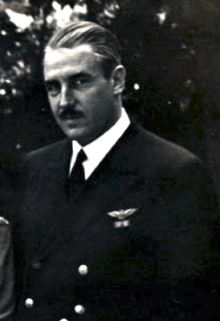Alfred Easton Poor
Alfred Easton Poor | |
|---|---|
 | |
| Born | May 24, 1899 Baltimore, MD |
| Died | January 13, 1988 (aged 88) New York, NY |
| Nationality | American |
| Alma mater | Harvard University, A.B., 1920 University of Pennsylvania, B. Arch., 1923; M. Arch., 1924 |
| Occupation | Architect |
| Buildings | Jacob K. Javits Federal Building James Madison Memorial Building, US Library of Congress |
| Projects | Wright Brothers National Memorial |
Alfred Easton Poor (May 24, 1899 – January 13, 1988) was an American architect noted particularly for buildings and projects in New York City and in Washington, D.C., for the U.S. government.
A son of Charles Lane Poor, Alfred Poor served in the U.S. Navy in World War I and in the U.S. Navy Reserve in World War II.[1]
As a student at the University of Pennsylvania, he studied under Paul Philippe Cret.[2][3]
Poor served as the president of the National Academy of Design in New York from 1966 to 1977, organizing its 150th anniversary in 1975.[4] He has been called "one of America's most prominent twentieth century architects"[2] and a "prominent member of the international school of modern architecture."[5]
Projects
Over his long career, Poor's projects included public and private-sector works.
Along with fellow New York architect Robert P. Rogers, Poor won the open international design competition for the Wright Brothers National Memorial in 1928.[2][3][4]
For the U.S. government, he worked on a project that restored and extended the East Front of the US Capitol building in the early 1960s,[2][4] and was also a leading architect in designing the US Library of Congress' James Madison Memorial Building,[4][6] the third-largest public building in Washington.[6]
Poor was especially active in the New York City area. His projects include the Jacob K. Javits Federal Building,[4][7] the Queens County Courthouse and prison in Kew Gardens,[4][8] the Home Insurance Company Building,[9][10] and the 40-acre Red Hook housing projects.[4]
Poor was chosen by Walter Annenberg to design the Annenberg School for Communication at the University of Pennsylvania.[2][11] His work was also part of the art competitions at the 1932 Summer Olympics and the 1936 Summer Olympics.[12]
According to his obituary in
Books
Poor's books about historical architecture include Formal Design in Minor French Buildings - The Tuileries Brochures (1931) and Colonial Architecture of
Personal life
References
- ^ Social Networks and Archival Context Project
- ^ a b c d e f Art of the Print
- ^ a b Library of Congress, American Treasures
- ^ a b c d e f g h Obituary, New York Times
- ^ Art History 3401, University of Minnesota
- ^ a b Library of Congress
- ^ New York Architecture - Jacob K. Javits Federal Office Building
- ^ "NYC.gov Website". Archived from the original on 2010-09-10. Retrieved 2011-01-19.
- ^ "In-Arch.net". Archived from the original on 2016-03-03. Retrieved 2011-01-20.
- ^ A View on Cities
- ^ University of Pennsylvania: An Architectural Tour. By George E. Thomas and Lewis Tanner
- ^ "Alfred Easton Poor". Olympedia. Retrieved July 31, 2020.
- ^ Cape Cinema, About
